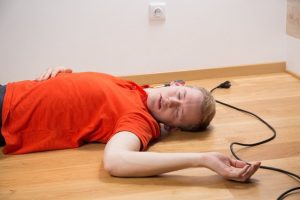By Stephen Burke. Last Updated 11th October 2024. Trailing leads hazards can present a risk of injury in the workplace, and if you’ve tripped over any kind of cable or wire as a result of negligence, you could claim compensation for your injuries. In this guide, we’ll walk you through what constitutes a trailing lead with a focus on how one could cause an accident at work and how to begin a personal injury claim.

Your employer has a legal responsibility to ensure your safety while at work as much as they reasonably can. Our advisers can help you learn more about your rights after an accident. In the meantime, read on to learn more about the specifics of this kind of claim.
If you’ve been injured as a result of a trailing lead or wire, get in touch with us to see if you could be eligible to claim:
- Call us at 0800 073 8801
- Contact an adviser via the live chat feature below
- Fill out our online contact form with your query
Select A Section
- Can I Claim For An Accident At Work Caused By Trailing Leads, Wires Or Cables?
- I Was Injured Due To Trailing Leads – How Long Do I Have To Claim?
- Examples Of How Trailing Leads Hazards Could Cause An Injury
- What Injuries Could Trailing Wires Cause?
- Evidence That Can Support Claims For Injuries Caused By Trailing Leads Hazards
- What Is The Average Compensation For An Accident At Work?
- Talk To A Specialist Solicitor
Can I Claim For An Accident At Work Caused By Trailing Leads, Wires Or Cables?
Under the Health and Safety at Work etc. Act 1974, your employer owes you a duty of care to take reasonable steps to protect your health and safety while you’re in the workplace and performing work-related tasks. As part of their duty, your employer should carry out tasks such as risk assessing the premises and identifying any potential trip hazards, such as trailing wires or leads. Any such hazards should be removed as soon as possible or clearly signposted to warn employees if the hazard can’t be removed immediately.
If you have been injured in a workplace accident caused by trailing leads or hazards similar to those, then you may be eligible to claim compensation if the following can be proven:
- Your employer owed you a duty of care.
- This duty was breached.
- The breach caused you to suffer an injury in a subsequent accident.
To learn more about what is a trailing leads accident at work claim and whether you have a valid case, please get in touch with our advisors for free today.
I Was Injured Due To Trailing Leads – How Long Do I Have To Claim?
If you suffered injuries from tripping on trailing wires and are eligible to claim compensation, you must start your claim within the relevant time limit. Generally, this is three years from the date of the accident that caused your injuries.
However, there are certain exceptions to this limitation period. This includes:
- Those who lack the mental capacity to start a claim for themself. The time limit is indefinitely suspended. If the person regains this capacity, they will have three years from the date they recovered this capacity to start one.
- Those under the age of 18. The time limit does not start until their 18th birthday. They will have three years from the date of their 18th birthday to start their own claim.
In both instances where the time limit is frozen, a litigation friend could claim on their behalf.
If you suffered injuries due to tripping over trailing leads and are unsure whether you could make a personal injury claim get in touch with one of our advisors. They can help answer your questions and offer you free advice.
Examples Of How Trailing Leads Hazards Could Cause An Injury
There are many ways in which trailing wires or trailing leads could cause an accident at work. For example:
- Lack of risk assessments: Sometimes, trailing wires and leads are unavoidable. In these situations, your employer should do a risk assessment to see if the risk can be mitigated, for example, with a slipcover. If your employer fails to do so, this could result in a slip or trip accident that causes you to sustain an injury, such as a broken bone.
- Cluttered walkways: Walkways should be kept clear and free from obstructions, such as trailing wires. If they aren’t, this could lead to an employee tripping and falling down a stairwell or over a guardrail. As a result, they might sustain a head injury or back injury.
- Electrocution: Damaged wires and cables can lead to electrocution. If an exposed wire is left trailing along the floor or overheard, accidental contact with it could lead to electrocution which could potentially result in a brain injury.
As we have already mentioned, you cannot claim for all accidents caused by trailing leads hazards. In order to form the basis of a valid claim, you have to be able to prove that your employer breached their duty of care, and this caused your injuries. To learn more, contact our team of advisors today.
What Injuries Could Trailing Wires Cause?
Accidents involving trailing wires or leads could result in a variety of injuries, including:
- Broken or fractured bones – You could suffer a broken bone due to trailing leads. For example, if you tripped over a wire and fell down the stairs, this could lead to a broken leg or a broken arm, for example. Even falls on the same level could lead to fractures or breaks.
- Back injuries – It could be possible for you to suffer a back injury after a fall over trailing leads, such as soft tissue injuries. In some cases, this could lead to long-term pain and disability.
- Head injuries – It could be possible for you to suffer a head injury if you fall, if you hit your head on a wall or the floor, for example. Some such injuries could cause injury to the brain.
- Sprains and strains – For example, you may suffer a sprained ankle injury after tripping over a loose wire. You could also suffer a strained wrist if you reached out to protect yourself when falling.
These are just a few examples. However, you must remember that in order to have a valid personal injury claim, your injuries must have directly resulted from your employer breaching their duty of care.
To learn more about claiming for injuries caused by trailing leads hazards, you can contact a member of our team.
Evidence That Can Support Claims For Injuries Caused By Trailing Leads Hazards
To help support your chances of your personal injury claim being a success, you should gather supporting evidence. This could include, but it not limited to:
- Medical records that confirm your injuries and treatment.
- Any video footage available that shows your accident, such as CCTV footage.
- Photographs of the trailing leads hazard and your visible injuries.
- The contact details of anyone who witnessed the accident and can provide a statement.
- A copy of the work accident report from the accident book.
If you have a solicitor to support your case, they can help you with gathering this and any additional evidence.
To see whether you may be eligible to work with one of our solicitors for your claim you can contact our advisors.
What Is The Average Compensation For An Accident At Work?
If you are successful in claiming compensation for your injuries caused by trailing wires, the compensation you would receive would depend on the facts and circumstances of your case. However, we can provide some guidance here on how compensation can be calculated.
A successful claim could result in general and special damages.
General damages is a head of claim that compensates you for the suffering and pain caused by your injuries. The Judicial College Guidelines (JCG) could be useful in helping those calculating such claims arrive at an appropriate amount. The JCG is a publication that provides guideline compensation brackets for different injuries. The table below, aside from the first figure, contains figures from the 2022 release of the JCG. However, this should only be used as guidance.
| Injury Type | Compensation Bracket | Notes |
|---|---|---|
| Multiple serious injuries plus special damages | Up to £1,000,000 + | Combinations of serious injuries that result in serious impacts on the person’s life and finances, such as a loss of earnings and medical expenses. |
| Very Severe Head Injury | £344,150 to £493,000 | There may be some ability to follow some basic commands but little meaningful response to the environment. Double incontinence and a need for full-time nursing care. |
| Severe Back Injuries (a) (i) | £111,150 to £196,450 | Injuries involving damage to the spinal cord and the nerve roots causing severe pain and disability. |
| Severe Knee Injuries (a) (i) | £85,100 to £117,410 | A serious injury to the knee in which the joint has been disrupted, leading to considerable pain and ligamentous damage as well as other issues. |
| Severe Knee Injuries (a) (ii) | £63,610 to £85,100 | A leg fracture that extends into the knee joint causing permanent and constant pain as well as limited movement. |
| Moderate Leg Injuries | £33,880 to £47,840 | Moderate injuries such as multiple fractures affecting one limb. |
| Less Serious Leg Injuries (i) | £21,920 to £33,880 | This bracket includes serious soft tissue injuries. |
| Wrist Injuries (b) | £29,900 to £47,810 | Significant injury with permanent disability but there is some remaining useful movement. |
| Moderate Ankle Injuries (c) | £16,770 to £32,450 | Fractures, strains, and sprains that result in disabilities of a less serious nature. |
| Serious Shoulder Injuries (b) | £15,580 to £23,430 | This bracket includes cases of restricted movement from a fractured humerus. |
Additionally, a payout for a successful claim could result in special damages, which compensate for the monetary costs and losses caused by your injuries.
These could include:
- Travel costs – for expenses incurred travelling to medical or solicitor’s appointments, for example.
- Care costs – for paid care at home because you couldn’t look after yourself because of your injuries.
- Medical expenses – for medical costs such as prescription fees.
- Loss of earnings – for pay lost because you couldn’t work due to your injuries.
When making a claim for special damages as part of your personal injury claim, you will need to provide evidence of your financial losses. This could include bank statements, invoices and payslips.
For a personalised estimate of your compensation or to ask anything else about personal injury claims caused by trailing leads hazards, please contact an advisor.

Talk To A Specialist Solicitor About Trailing Leads Hazards
You may find the process of making a compensation claim for your injuries easier with the support and guidance of a solicitor. However, you might be hesitant to do so if you’re expected to pay upfront fees to your lawyer with no guarantee that your claim will be a success.
If you select Accident Claims UK to assist in your claim, you could be offered a type of No Win No Fee Agreement known as a Conditional Fee Agreement (CFA). This means you will generally have:
- No upfront fees to get your claim started
- No fees to pay at any point during the claim process
- No fees to pay for your lawyer’s services if your claim is unsuccessful
If your personal injury claim is successful, you will pay a small success fee from the compensation you are awarded, made up of a percentage that is capped by law.
If you’re thinking of making a personal injury claim because of an accident to do with trailing leads hazards, get in touch using the details below:
- Call us at 0800 073 8801
- Contact an adviser via the live chat feature below
- Fill out our online contact form with your query
Slip, Trip And Fall Claim Guides
Below, you can find links to some more of our guides on accident at work claims:
- Head here to view our Accident At Work FAQs
- You can learn more about making an accident at work claim here
- Learn how to make tendon injury at work claims
- A guide to factory accident claims
- How to sue for carbon monoxide poisoning at work
- Find answers to questions on what to do if you have an accident at your workplace
- See if you can claim if you were attacked as a lone worker
- Head here for examples of fall at work compensation payouts
- A guide to construction accident claims for compensation
- What to do if you slipped on a wet floor at work
- Here’s a guide on injuries caused by dangerous machinery at work
- See if you can make a No Win No Fee accident at work claim
- Find examples of payouts for fatal accidents at work
You might also find the links below useful:
- Statutory Sick Pay – Government information about statutory sick pay
- When to visit a walk-in centre– An NHS guide on when to visit an urgent treatment centre
- Request CCTV footage of yourself – A government guide to requesting CCTV footage that you appear in
Hopefully, this guide has answered some of the questions you have about claiming for accidents caused by trailing leads hazards. If you need any more information, don’t hesitate to contact us using the details below.



